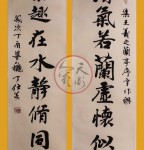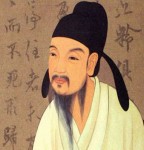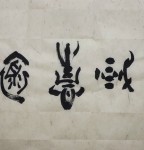| Article Index |
|---|
| Aesthetics & Philosophy About Chinese Calligraphy |
| Search for Beauty |
| Understanding for Beauty |
| All Pages |
"Let us worry about beauty first, and truth will take care of itself."
What is beauty? Philosophers pondering the meaning of aesthetics have produced weighty tomes, but an absolute definition of aesthetic values remains elusive. Aesthetic perceptions differ from culture to culture. Different conventions govern landscape painting in the East and West. If there is no objective standard of beauty in the world of human creations, what system of aesthetics are we to use in speaking of the beauty of the Nature?
How are we to judge the Nature's design to benefit an artist’s creation? Or how a non-Chinese speaking people perceive the abstract beauty within a Chinese calligraphy work?
It is “perception” of our basic senses that drive us to make things better, be it for delicious cooking, melodious music or beautiful painting. However, everyone’s perception is different. So artists as well as critics “set” criteria for appreciating art and traditional rules and norms to create good arts. Why criteria for arts? And why do we need to learn traditional rules and norms? If art does not impose some norms or standards, then everybody can have it in his own way without learning and practicing. Consequently, people won’t appreciate each other’s ways. Just as languages and music have their own grammars, Chinese calligraphy has numerous sets of strict rules, norms, and esthetics.
For example, a major rule of Tsao Shu is to simplify the left radical of a Chinese character and focus on the right radical (“Yi Zuo Yang Yu 抑左揚右,” literally simplify the left and focus on the right.) This rule makes writing the left part of a character faster by connecting it from the right part of the preceding character. Thus a calligraphy work in Tsao Style will look more smooth, connecting, and faster with abrupt turning and dramatic effects.
The following is a chart that lists each character in Kai Style and three ways of writing that character in Tsao Style. Like Zuan Style, a character can be written in many ways in Tsao Style.
From the above examples, we may know “simplifying the left and focusing on the right” is the major rule for creating a Tsao Style character by different ancient calligraphers. The calligraphers obey the prototype more strictly on the left side while they have leeway for artistic design on the right side. If a laymen tries to coin his way of creating a Tsao Style character without learning, he may end up making mistakes. Adding or removing a single dot in one position can turn a Tsao Style character into another one. For example, “Wei #2” and “Zu #3” are just different in one dot in the beginning and another dot at the end. There are innumerous examples in Tsao Shu of tiny differences like this example since the total number of Chinese characters is so large.
However, rules are not absolute. A rule that is not allowed in one Chinese calligraphy style may be a specialized feature in the other styles. For example, Emperor Huei Zong ( 宋徽宗 ) of the Sung Dynasty invented Skinny Gold Style “So Jin Tee 瘦金體” that adopted strokes with principles against traditional rules and theories. It was “that” calligrapher’s perception that made him not to adopt traditional rules of most Chinese calligraphy methodologies and that made him unique and different.
| < Prev | Next > |
|---|
- 2011-04-07 - Chu Suiliang 褚遂良, one of the Four Great Calligraphers of Early Tang Dynasty
- 2011-01-07 - 文徵明行书《明妃曲》
- 2010-12-20 - Philosophy About Chinese Calligraphy
- 2010-08-10 - Laozi (Lao-tzu, fl. 6th C. BCE)
- 2010-08-08 - The Dragon's Embrace - China's Soft Power Is a Threat to the West
- 2010-04-19 - The Core of Chinese Culture
- 2010-03-12 - Bringing it All Back Home: Chu Teh-Chun at NAMOC












